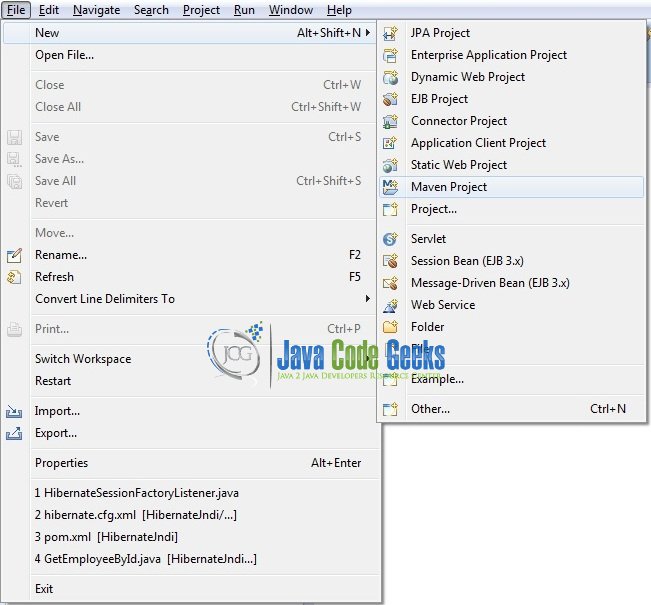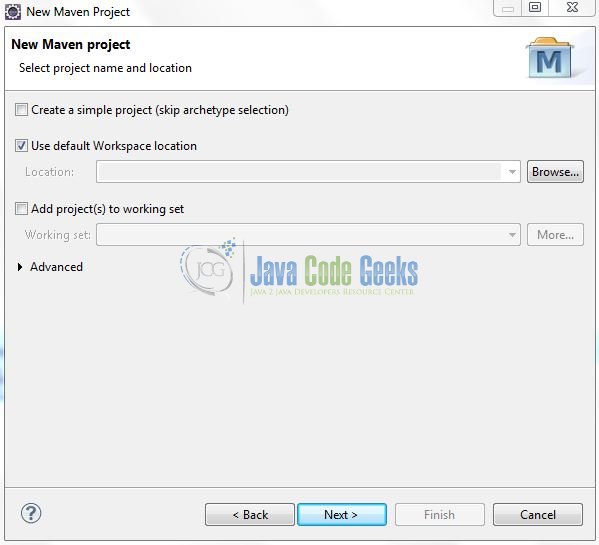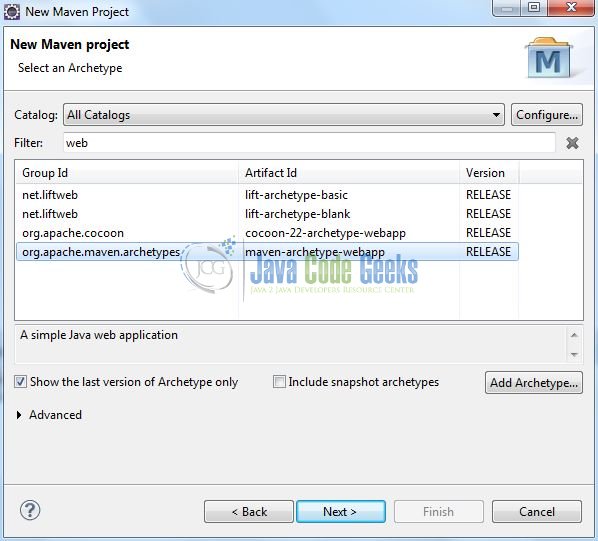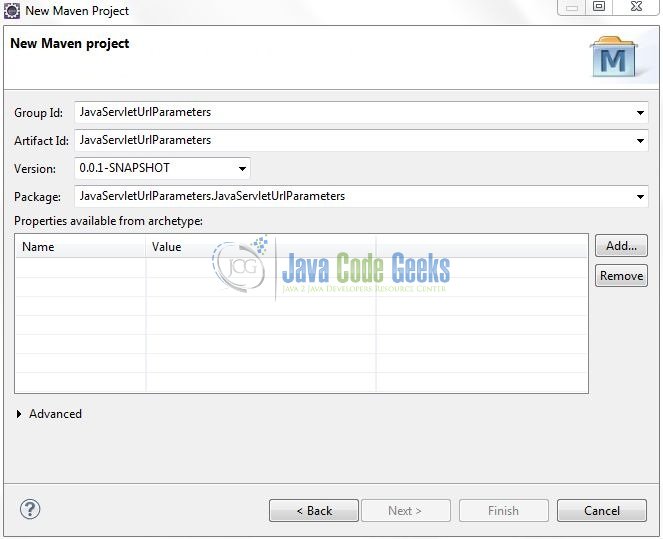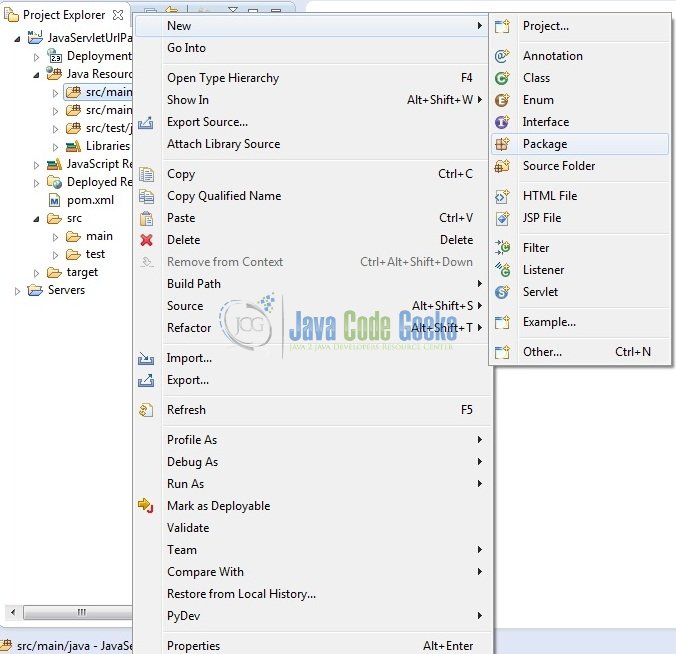Java Servlet Url Parameters Example
Servlets are modules of the Java code that run in a server application to answer the client requests. They are not tied to a specific client-server protocol but are most commonly used with HTTP. The word “Servlet” is often used in the meaning of “HTTP Servlet” . In this tutorial, we will explain how to handle parameters of the Servlet HTTP Request.
1. Introduction
Servlet is a Java program which exists and executes in the J2EE servers and is used to receive the HTTP protocol request, process it and send back the response to the client. Servlets make use of the Java standard extension classes in the packages javax.servlet and javax.servlet.http. Since Servlets are written in the highly portable Java language and follow a standard framework, they provide a means to create the sophisticated server extensions in a server and the operating system in an independent way.
Typical uses for HTTP Servlets include:
- Processing and/or storing the data submitted by an HTML form
- Providing dynamic content i.e. returning the results of a database query to the client
- Managing state information on top of the stateless HTTP i.e. for an online shopping cart system which manages the shopping carts for many concurrent customers and maps every request to the right customer
As Servlet technology uses the Java language, thus web applications made using Servlet are Secured, Scalable, and Robust.
1.1 Servlet Architecture & Lifecycle
A Servlet, in its most general form, is an instance of a class which implements the javax.servlet.Servlet interface. Most Servlets, however, extend one of the standard implementations of this interface, namely javax.servlet.GenericServlet and javax.servlet.http.HttpServlet. In this tutorial, we’ll be discussing only HTTP Servlets which extends the javax.servlet.http.HttpServlet class.
In order to initialize a Servlet, a server application loads the Servlet class and creates an instance by calling the no-args constructor. Then it calls the Servlet’s init(ServletConfig config) method. The Servlet should perform the one-time setup procedures in this method and store the ServletConfig object so that it can be retrieved later by calling the Servlet’s getServletConfig() method. This is handled by the GenericServlet. Servlets which extend the GenericServlet (or its subclass i.e. HttpServlet) should call the super.init(config) at the beginning of the init method to make use of this feature.
Signature of init() method
public void init(ServletConfig config) throws ServletException
The ServletConfig object contains the Servlet parameters and a reference to the Servlet’s ServletContext. The init method is guaranteed to be called only once during the Servlet’s lifecycle. It does not need to be thread-safe because the service() method will not be called until the call to the init() method returns.
When the Servlet is initialized, its service(HttpServletRequest req, HttpServletResponse resp) method is called for every request to the Servlet. The method is called concurrently (i.e. multiple threads may call this method at the same time) as it should be implemented in a thread-safe manner. The service() method will then call the doGet() or doPost() method based on the type of the HTTP request.
Signature of service() method
public void service(HttpServletRequest req, HttpServletResponse resp) throws ServletException, IOException
When the Servlet needs to be unloaded (e.g. because a new version should be loaded or the server is shutting down), the destroy() method is called. There may still be threads that execute the service() method when the destroy() method is called, so destroy() method has to be thread-safe. All resources which were allocated in the init() method should be released in the destroy() method. This method is guaranteed to be called only once during the Servlet’s lifecycle.
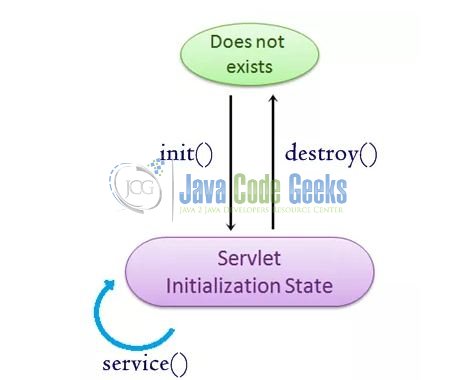
1.2 Servlet Container
Servlet Container is a component which loads the Servlets and manages the Servlet life cycle and responds back with the dynamic content to the HTTP server. Servlet container is used by the HTTP server for processing the dynamic content and Tomcat is a perfect example for the Servlet Container.
The Servlet Container performs operations that are given below:
- Life Cycle Management
- Multithreaded Support
- Object Pooling
- Security etc.
1.3 Get vs. Post Request
There are many differences between the HTTP Get and Post request. Let’s see these differences:
| Feature | GET | POST |
|---|---|---|
| Sending of data | Client data is appended to URL and sent | Client data is sent separately |
| Storing in the Browser History | As data is appended, the client data is stored in the browser history | As data is sent separately, the client data is not stored in the browser history |
| Bookmark | The URL with client data can be bookmarked. Thereby, later without filling the HTML form, the same data can be sent to server | Not possible to bookmark |
| Encoding or enctype | application/x-www-form-urlencoded | application/x-www-form-urlencoded or multipart/form-data. For binary data, multipart encoding type is used |
| Limitation of data sent | Limited to 2048 characters (browser dependent) | Unlimited data |
| Hacking easiness | Easy to hack the data as the data is stored in the browser history | Difficult to hack as the data is sent separately in an HTML form |
| Type of data sent | Only ASCII data can be sent | Any type of data can be sent including the binary data |
| Data secrecy | Data is not secret as other people can see the data in the browser history | Data is secret as not stored in the browser history |
| When to be used | Prefer when data sent is not secret. Do not use for passwords etc. | Prefer for critical and sensitive data like passwords etc. |
| Cache | Can be caught | Cannot be caught |
| Default | If not mentioned, GET is assumed as default | Should be mentioned explicitly |
| Performance | Relatively faster as data is appended to URL | A separate message body is to be created |
Do remember, if client data includes only the ASCII characters i.e. no secrecy and the data is limited to 2 KB length, then prefer GET, else POST.
1.4 Servlet Advantages
There are many advantages of Servlet over CGI (Common Gateway Interface). The Servlet Web Container creates threads for handling the multiple requests to the Servlet. Threads have a lot of benefits over the processes such as they share a common memory area, lightweight, cost of communication between the threads are low. The basic benefits of Servlet are as follows:
- Less response time because each request runs in a separate thread
- Servlets are scalable
- Servlets are robust and object-oriented
- Servlets are platform-independent
- Servlets are secure and offer portability
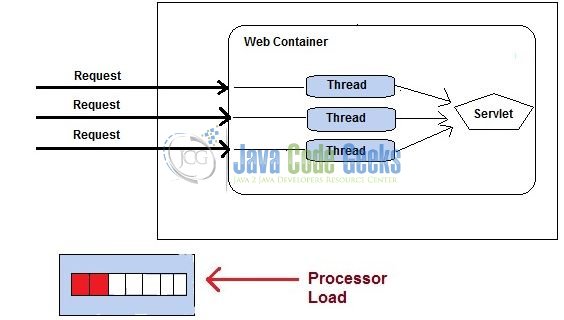
Now, open up the Eclipse IDE and let’s see how to retrieve the Url parameters in a Servlet!
2. Java Servlet Url Parameters Example
Here is a step-by-step guide for implementing the servlet framework in Java.
2.1 Tools Used
We are using Eclipse Kepler SR2, JDK 8 and Maven. Having said that, we have tested the code against JDK 1.7 and it works well.
2.2 Project Structure
Firstly, let’s review the final project structure, in case you are confused about where you should create the corresponding files or folder later!
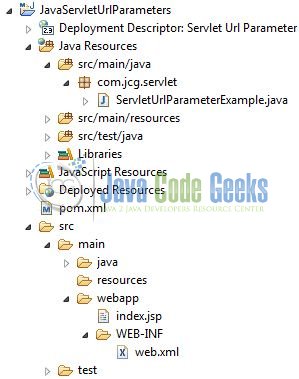
2.3 Project Creation
This section will demonstrate on how to create a Java-based Maven project with Eclipse. In Eclipse IDE, go to File -> New -> Maven Project.
In the New Maven Project window, it will ask you to select project location. By default, ‘Use default workspace location’ will be selected. Just click on next button to proceed.
Select the Maven Web App Archetype from the list of options and click next.
It will ask you to ‘Enter the group and the artifact id for the project’. We will input the details as shown in the below image. The version number will be by default: 0.0.1-SNAPSHOT.
Click on Finish and the creation of a maven project is completed. If you observe, it has downloaded the maven dependencies and a pom.xml file will be created. It will have the following code:
pom.xml
<project xmlns="http://maven.apache.org/POM/4.0.0" xmlns:xsi="http://www.w3.org/2001/XMLSchema-instance" xsi:schemaLocation="http://maven.apache.org/POM/4.0.0 http://maven.apache.org/xsd/maven-4.0.0.xsd"> <modelVersion>4.0.0</modelVersion> <groupId>JavaServletUrlParameters</groupId> <artifactId>JavaServletUrlParameters</artifactId> <version>0.0.1-SNAPSHOT</version> <packaging>war</packaging> </project>
We can start adding the dependencies that developers want like Servlets, Junit etc. Let’s start building the application!
3. Application Building
Below are the steps involved in developing this application.
3.1 Maven Dependencies
Here, we specify the dependencies for the Servlet API. The rest dependencies will be automatically resolved by the Maven framework and the updated file will have the following code:
pom.xml
<project xmlns="http://maven.apache.org/POM/4.0.0" xmlns:xsi="http://www.w3.org/2001/XMLSchema-instance"
xsi:schemaLocation="http://maven.apache.org/POM/4.0.0 http://maven.apache.org/maven-v4_0_0.xsd">
<modelVersion>4.0.0</modelVersion>
<groupId>JavaServletUrlParameters</groupId>
<artifactId>JavaServletUrlParameters</artifactId>
<packaging>war</packaging>
<version>0.0.1-SNAPSHOT</version>
<name>JavaServletUrlParameters Maven Webapp</name>
<url>http://maven.apache.org</url>
<dependencies>
<dependency>
<groupId>javax.servlet</groupId>
<artifactId>javax.servlet-api</artifactId>
<version>3.1.0</version>
</dependency>
</dependencies>
<build>
<finalName>${project.artifactId}</finalName>
</build>
</project>
3.2 Java Class Creation
Let’s create the required Java files. Right-click on src/main/java folder, New -> Package.
A new pop window will open where we will enter the package name as: com.jcg.servlet.
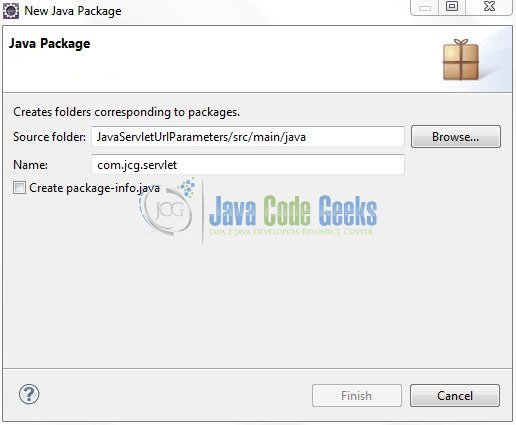
Once the package is created in the application, we will need to create the controller class. Right-click on the newly created package: New -> Class.
A new pop window will open and enter the file name as: ServletUrlParameterExample. The Servlet Controller class will be created inside the package: com.jcg.servlet.
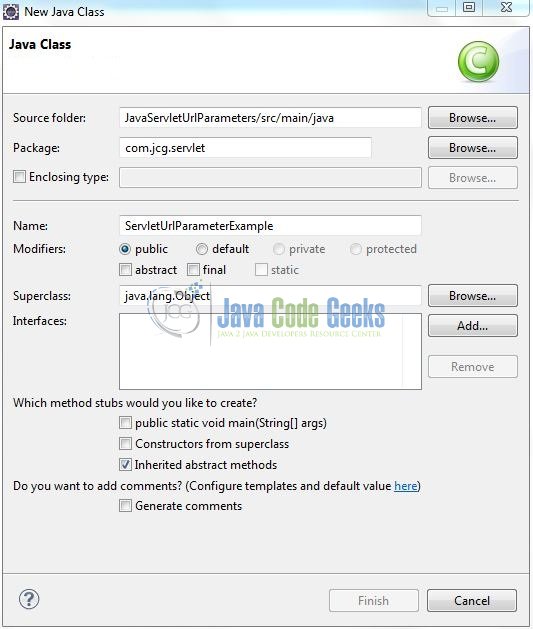
3.2.1 Implementation of Servlet Controller Class
In an HTTP GET request, the request parameters are taken from the query string (i.e. the data following the question mark in the URL). For example, the URL http://hostname.com?p1=v1&p2=v2 contains the two request parameters i.e. p1 and p2. Let’s see the simple code snippet that follows this implementation.
ServletUrlParameterExample.java
package com.jcg.servlet;
import java.io.IOException;
import java.io.PrintWriter;
import java.util.Arrays;
import javax.servlet.annotation.WebServlet;
import javax.servlet.http.HttpServlet;
import javax.servlet.http.HttpServletRequest;
import javax.servlet.http.HttpServletResponse;
@WebServlet("/getParameters")
public class ServletUrlParameterExample extends HttpServlet {
private static final long serialVersionUID = 1L;
// This Method Is Called By The Servlet Container To Process A 'GET' Request.
public void doGet(HttpServletRequest req, HttpServletResponse resp) throws IOException {
handleRequest(req, resp);
}
public void handleRequest(HttpServletRequest req, HttpServletResponse resp) throws IOException {
resp.setContentType("text/html");
// Get Parameters From The Request
String param1 = req.getParameter("param1");
String param2 = req.getParameter("param2");
String[] paramArray = req.getParameterValues("paramArray");
if(param1 == null || param2 == null || paramArray == null) {
// The Request Parameters Were Not Present In The Query String. Do Something Or Exception Handling !!
} else if ("".equals(param1) || "".equals(param2) || "".equals(paramArray)) {
// The Request Parameters Were Present In The Query String But Has No Value. Do Something Or Exception Handling !!
} else {
System.out.println("Parameter1?= " + param1 + ", Parameter2?= " + param2 + ", Array Parameters?= " + Arrays.toString(paramArray));
// Print The Response
PrintWriter out = resp.getWriter();
out.write("<html><body><div id='serlvetResponse'>");
out.write("<h2>Servlet HTTP Request Parameters Example</h2>");
out.write("<p>param1: " + param1 + "</p>");
out.write("<p>param2: " + param2 + "</p>");
out.write("<p>paramArray: " + Arrays.toString(paramArray) + "</p>");
out.write("</div></body></html>");
out.close();
}
}
}
4. Run the Application
As we are ready with all the changes, let us compile the project and deploy the application on the Tomcat7 server. To deploy the application on Tomat7, right-click on the project and navigate to Run as -> Run on Server.
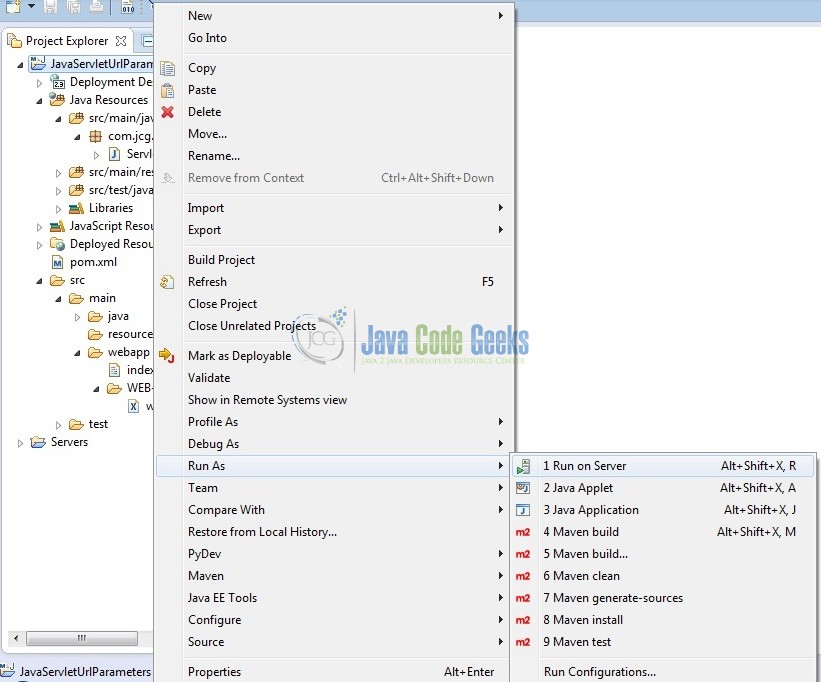
Tomcat will deploy the application in its web-apps folder and shall start its execution to deploy the project so that we can go ahead and test it on the browser.
5. Project Demo
Open your favorite browser and hit the following URL. The output page will be displayed.
http://localhost:8085/JavaServletUrlParameters/
Server name (localhost) and port (8085) may vary as per your tomcat configuration. Developers can debug the example and see what happens after every step. Enjoy!
That’s all for this post. Happy Learning!!
6. Conclusion
In this section, developers learned how to retrieve the request parameters in a Servlet. Developers can download the sample application as an Eclipse project in the Downloads section. I hope this article has served you whatever you were looking for as a developer.
7. Download the Eclipse Project
This was an example of Servlet Url Parameters.
You can download the full source code of this example here: JavaServletUrlParameters


